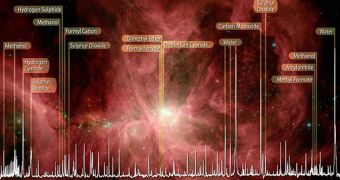Astronomers using the European Space Agency's (ESA) Herschel Space Observatory announce the discovery of organic molecules that may potentially enable life. The chemicals were discovered in the famous Orion Nebula.
The stellar nursery is located within our own galaxy, the Milky Way. According to the research team, the observatory was able to use a spectrograph instrument to determine that certain chemical fingerprints in the light it was analyzing came from life-enabling, organic molecules.
ESA officials say that the Heterodyne Instrument for the Far Infrared (HIFI) is an extremely-advanced spectrometer, capable of operating in two distinct bands. The first one spans between 157 and 212 micrometers and the second one from 240 to 625 micrometers.
The Orion Nebula is known as one of the most complex chemical-producing installations in the galaxy, but thus far investigators did not detect signs of organic molecules within. Herschel was able to do so because it is the best space telescope science has available today.
Some of the chemicals the researchers found include water, carbon monoxide (CO), formaldehyde, methanol, dimethyl ether, hydrogen cyanide, sulfur oxide (SO) and sulfur dioxide (SO2). Most of them can set the foundation for life in their own right.
Other objects, such as the massive molecular cloud Sagittarius B2(N), may also hold similar molecules. The cloud is currently being investigated using the Robert C. Byrd Green Bank Telescope (GBT), one of the largest telescopes in the world.
“Clouds like this one are the raw material for new stars and planets. We know that complex chemistry builds prebiotic molecules in such clouds long before the stars and planets are formed,” expert Anthony Remijan explains, quoted by Daily Galaxy.
“There is a chance that some of these interstellar molecules may find their way to the surface of young planets such as the early Earth, and provide a head start for the chemistry of life,” adds the scientist, who is based at the National Radio Astronomy Observatory (NRAO).
“For the first time, we now have the capability to make a very thorough and methodical search to find all the chemicals in the clouds,” he goes on to say. The fact that we have instruments such as Herschel at our disposal is indeed making the search a lot easier.

 14 DAY TRIAL //
14 DAY TRIAL //